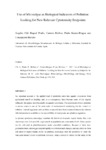Use of Microalgae as Biological Indicators of Pollution: Looking for New Relevant Cytotoxicity Endpoints

Use este enlace para citar
http://hdl.handle.net/2183/16634Coleccións
- Investigación (FCIE) [1243]
Metadatos
Mostrar o rexistro completo do ítemTítulo
Use of Microalgae as Biological Indicators of Pollution: Looking for New Relevant Cytotoxicity EndpointsData
2012Cita bibliográfica
Cid, A., Prado, R., Rioboo, C., Suarez-Bregua, P, and Herrero, C. 2012. Use of Microalgae as Biological Indicators of Pollution: Looking for New Relevant Cytotoxicity Endpoints. In: Johnsen, M. N. (ed.) Microalgae: Biotechnology, Microbiology and Energy. Nova Science Publishers, New York. pp: 311-323.
Resumo
An important amount of the applied load of pesticides enter into aquatic ecosystems from agricultural runoff or leaching and, as a consequence, have become some of the organic pollutants that appear most frequently on aquatic ecosystems. The assessment of toxic potential in surface water is one of the main tasks of environmental monitoring for the contro1 of pollution. Animal organisms such as fishes or mussels have been examined intensively whereas little information is available on the susceptibility of water plants and plankton organisms.
As primary producers, microalgae constitute the first level of aquatic trophic chains. Due to its microscopic size, it is possible to get sample at population and community levels. Some species can be cultivated in photobioreactors under controlled conditions. Because of their short generation times, microalgae respond rapidly to environmental changes, and any effect on them will affect to higher trophic levels. In addition, microalgae offer the possibility to study the trans-generational effects of pollutant exposure, being a model of choice for the study of the long term effects of pollutant exposure at population level. Furthermore, micro algal tests are generally sensitive, rapid and low-cost effective. For all these reasons, the use of microalgal toxicity tests is increasing, and today these tests are frequently required by authorities for notifications of chemicals and are also increasingly being used to manage chemical discharges. For example, algal toxicity tests of chemicals are mandatory tests for notification of chemicals in the European Union countries. Others fields of use for algae in toxicity assessment are industrial wastewaters and leachates from waste deposits.
Cytotoxic effects of aquatic pollutants on microalgae are very heterogeneous, and they are influenced by the environmental conditions and the test species. Growth, photosynthesis, chlorophyll fluorescence and others parameters reflect the toxic effects of pollutants on microalgae; however, other relevant endpoints are less known because experimental difficulties, especially under in vivo conditions.
During the last two decades, our research group has a high priority scientific objective: study the effect of different aquatic pollutants on freshwater microalgae, with the aim to develop new methods for the detection of contaminants based on the physiological response of microalgae, with the purpose of providing an early warning signal of sub lethal levels of pollution.
Palabras chave
Pesticides
Cytotoxicology
Aquatic pollutants
Freshwater microalgae
Biological indicators
Cytotoxicity endpoints
Cytotoxicology
Aquatic pollutants
Freshwater microalgae
Biological indicators
Cytotoxicity endpoints
ISBN
978-1-61324-625-2





